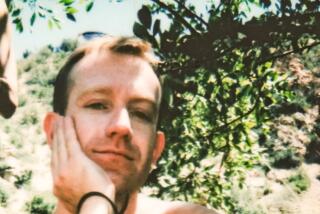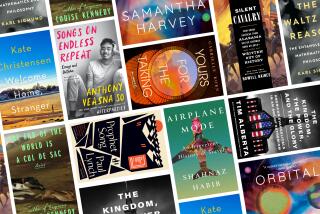Just think about it
Anathem
A Novel
Neal Stephenson
William Morrow: 936 pp., $29.95
WHEN C.P. Snow delivered his famous lecture on the “Two Cultures” in 1959, he pointed out that the sciences and the humanities seemed to be running along increasingly disconnected tracks. But what if these two cultures were separated not just by differences in principles, interests and standards, but were physically divided as well?
“What if?” is the purview of the science-fiction novelist, and in “Anathem,” Neal Stephenson, newly finished with an extended foray into the realm of historical fiction (“Cryptonomicon” and the massive three-volume Baroque Cycle), answers that question by returning to the genre he calls home. “Anathem” is massive also -- 900-plus pages -- with a steep initial learning curve, but worth the effort all the same.
Fiction that expertly ranges from social satire to adventure yarn to lucid explications of concepts such as configuration space is rare indeed. If Indiana Jones turned quantum physicist and took over Jostein Gaarder’s bestselling novel-cum-philosophy-primer “Sophie’s World,” well, that might come close.
The world of “Anathem” is an alternate version of our own, a not unfamiliar science-fiction premise. Here, though, the disparities assume a pointed significance as the story unfolds.
The narrator, Fraa Erasmas, belongs to a “math,” a community of scholars and thinkers who live like monks, sequestered from the distractions and corruption of the “Saecular” world.
Yet as much as the maths resemble monastic orders (down to their ascetic way of life and many rituals), the members, or “avout,” mostly don’t believe in God. Instead, they are committed to “theorics,” a collection of disciplines “[r]oughly equivalent to mathematics, logic, science, and philosophy on Earth.” (That last quote is from the glossary at the back of “Anathem,” very handy when reading the first few chapters of the book.)
Forbidden within the maths are most forms of advanced technology; as the novel gradually discloses, this taboo is the result of an ancient agreement with Saecular authorities, intended to slow technological change to a rate at which it can be, as one character puts it, “understood, managed, controlled.” A few maths, called Millenarians, have gone so far in embracing this ethos of exclusion that they only open their gates once every thousand years and are otherwise cut off from the world.
Inside the cloisters, avouts pursue theoretical physics, mathematics and astronomy; outside, the largely aliterate society gorges itself on movies, junk food and abundant supplies of genetically engineered mood-enhancing drugs, as well as politics, cellphone/Blackberry devices called (delightfully) “jeejahs” and religion. The Saecular world regards the maths -- especially the mysterious Millenarians -- with varying degrees of suspicion, curiosity and awe. (Erasmas, our narrator, is only a garden-variety Decenarian, which means his math holds an open house every 10 years.)
On his acknowledgments page, Stephenson describes “Anathem” as “a fictional framework for exploring ideas that have sprung from the minds of great thinkers of Earth’s past and present.” At the heart of this exploration is a conflict between two major strands of Western thought that, in recent years, correspond to analytic and continental philosophy. Is philosophy primarily a matter of language and the working out of a consistent structure of reasoning about data that we experience directly, with our senses? Or are there fundamental truths accessible only through philosophy and the highest modes of thought?
Is the number 2, in other words, no more than a conceptual tool, a product of the human mind? Or is the 2 we know merely the shadow of an ideal reality that we perceive through a glass, and darkly? To judge by “Anathem,” Stephenson comes down on the side of the latter, which makes him something of a Platonist, a believer in a transcendent reality, and an adherent to a position intellectually out of fashion in the humanities departments of most Western universities.
This may not sound like the stuff of compelling fiction, and the fact that the characters in “Anathem” occasionally engage in Socratic-style dialogues on these (and related) topics might scare some readers off. But that would be a mistake. Stephenson has done something remarkable in this novel, which is to make the resolution of a venerable philosophical debate essential to the unfolding of his story.
Fraa Erasmas and his mathic colleagues are “evoked” (that is, called forth from the math by the Saecular authorities) when their world faces an unprecedented crisis requiring their expertise. One solution may lie in cryptic hints left behind by a beloved, exiled teacher. The avouts’ conversations about geometry and quantum states aren’t intellectual detours from a perfunctory plot; they are one of the forms the story takes. “Anathem” turns what often seem like airless, abstract debates into matters of life and death. In order to save the world it becomes crucial to determine what the world really is.
Along the way, there are disguises and secret societies and martial arts. There is a near-lynching in a frontier town and a spectacular, massive train made of sledges that ferries people and cargo over the North Pole.
Erasmas and company go on to exploits even more thrilling, but I will leave them aside here because part of the pleasure of “Anathem” is that it begins so quietly, in Erasmas’ alluringly tranquil monastic community, and winds up traveling so far. Whenever you feel you have a handle on the story, at the moment you settle in, thinking, “Now I see what this book is about,” the novel is liable to pivot on some previously unnoticed axis and head in another direction entirely.
“Anathem” is also a campus novel, a counterpoint to Stephenson’s little-known debut, “The Big U.” Despite their “bolts” (habits) and quasi-liturgical chanting, the avouts are in essence graduate students, and the maths resemble nothing so much as idealized universities, in which knowledge is doggedly pursued for its own sake in defiance of a hedonistic, utilitarian society with a vanishingly small attention span.
The book even features its own version of postmodernism and the culture wars; “Anathem” gleefully exacts the physics majors’ revenge on the slippery relativists who often run circles around them in faculty lounges and coffee shops. If the good guys believe in something called the Hylaean Theoric World (the equivalent of Plato’s forms), their opponents are treacherous, media-savvy sophists who say things like, “language, communication, indeed thought itself, are the manipulation of symbols to which meaning are assigned by culture -- and only by culture.”
This makes a refreshing change from the usual literary depictions of scientists and mathematicians as inflexible rationalists unable to apprehend that emotional nuance is what really matters in life.
True, Erasmas is a bit callow (his cluelessness in romantic matters is one of the novel’s running jokes), and his workmanlike first-person voice strips the customary brio out of Stephenson’s prose. But what could be more literary than the metaphysical conclusions the novel wends its way to, which are that human imagination is a quantum device and the cosmos itself a kind of story?
By metaphorical extension, that makes a novelist if not quite a god (never that!), then at the very least, the next best thing.
More to Read
Sign up for our Book Club newsletter
Get the latest news, events and more from the Los Angeles Times Book Club, and help us get L.A. reading and talking.
You may occasionally receive promotional content from the Los Angeles Times.






